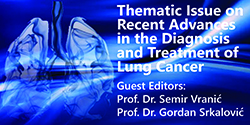Comparison of double disk synergy test, VITEK 2 and Check-MDR CT102 for detection of ESBL producing isolates
DOI:
https://doi.org/10.5644/ama2006-124.66Abstract
Objective. This study is to define the statistical significance for detection of ESBL producers by the double disk synergy test and molecular test (Check-MDR CT102), microdilution test (VITEK 2 with AES) and double disk synergy test (DDST), as well as the microdilution test and molecular test. Materials and methods. Phenotypic testing of 55 isolates Enterobacteriaceae (Escherichia coli (14/55), Klebsiella pneumoniae (34/55), Klebsiella oxytoca (3/55) and Proteus mirabilis (4/55) was performed by VITEK 2 Compact/AES. When this test showed positive results for the ESBL phenotype, then DDST with amoxicillin/clavulanate, ceftazidime, cefpodoxime, aztreonam, ceftriaxone and cefoxitin disks was performed along with Check-MDR CT102 which identified CTX-M, TEM and SHV β-lactamases. Results. Applying the McNemar test, we determined that there was a statistically significant difference in the results of detection of ESBLs bacteria using DDST compared to molecular methods (95% CI=41.92 to 54.55; p<0.0001), as well as a DDST and VITEK 2/AES (95% CI=40.13 to 52.73; p<0.0001). We did not find any statistically significant difference in the results of detection of ESBL producers using molecular techniques and VITEK 2/AES (CI=-4,43 to 5,36; p=1). Also we did not find any statistical.. difference between the resistance to cefpodoxime and ceftriaxone (50/50) compared to the results of molecular tests. Conclusion. In routine daily testing, good detection of ESBLs bacteria, especially CTX-M can be obtained with phenotypic methods with VITEK 2/AES and by DDST with cefpodoxime, and ceftriaksone disks.Downloads
Published
17.05.2013
Issue
Section
Clinical Science
How to Cite
Comparison of double disk synergy test, VITEK 2 and Check-MDR CT102 for detection of ESBL producing isolates. (2013). Acta Medica Academica, 42(1), 15-24. https://doi.org/10.5644/ama2006-124.66






